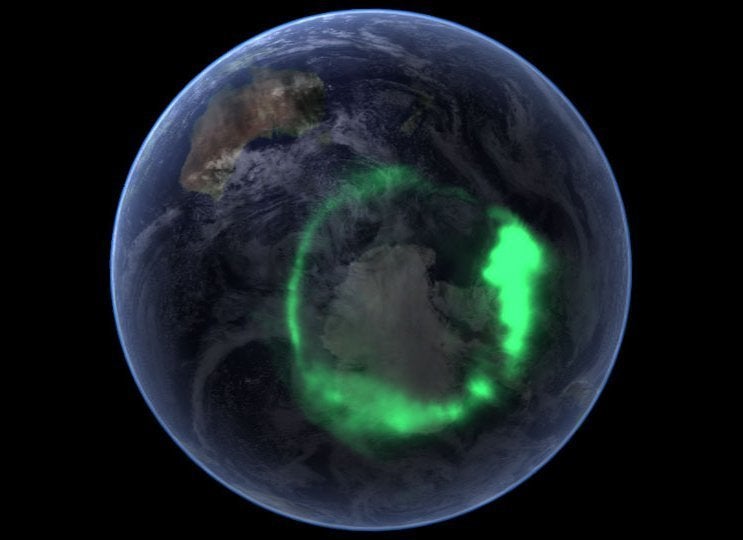By: Space.com, staff
Published: 01/14/2013 05:09 PM EST on SPACE.com
A huge sun eruption on Sunday (Jan. 13) unleashed a wave of solar plasma aimed at Earth that may amplify the planet's northern lights displays later this week, NASA scientists say.
The solar eruption, called a coronal mass ejection (CME), occurred at 2:24 a.m. EST (0724 GMT) on Sunday and should take about three days to reach Earth, researchers said. The space weather event is not strong enough to interfere with satellites or electrical systems on Earth, they added.
Observations from NASA's twin Solar Terrestrial Relations Observatory spacecraft the Solar and Heliospheric Observatory showed that the CME shot away from sun at speeds of 275 miles per second — about 990,000 mph (1.6 million kilometers per hour).

This image from NASA's Solar Dynamics Observatory was captured on Jan. 13, 2013, at 8:13 p.m. EST. At the center sits a large cluster of sunspots, dubbed Active Region 11654.
Solar storms of this speed are fairly typical and have not caused substantial geomagnetic storms in the past, NASA officials said in a statement. Geomagnetic storms occur when the charged solar particles interact with the Earth's Earth's magnetic field, which can cause problems for satellites, communications, and power grids.
But solar storms similar to Sunday's eruption can produce supercharged northern and southern lights at the Earth's poles, NASA officials said.
The sun is in an active phase of its current 11-year weather cycle, which scientists call Solar Cycle 24. The sun's activity cycle is expected to reach its peak this year.
Two particularly active sunspot regions, called AR 11652 and AR 11654, have produced four low-level M-class flares since Jan. 11, space weather officials said. The most powerful solar flares, X-class flares, have the most significant effect on Earth. They can cause long-lasting radiation storms in our planet's upper atmosphere and trigger radio blackouts.
Medium-size M-class flares can cause brief radio blackouts in the polar regions and occasional minor radiation storms. C-class flares, the weakest in scientists' three-tiered classification system, have few noticeable consequences.
Follow SPACE.com on Twitter @Spacedotcom. We're also on Facebook and Google+.
Copyright 2013 SPACE.com, a TechMediaNetwork company. All rights reserved. This material may not be published, broadcast, rewritten or redistributed.
Support HuffPost
Our 2024 Coverage Needs You
Your Loyalty Means The World To Us
At HuffPost, we believe that everyone needs high-quality journalism, but we understand that not everyone can afford to pay for expensive news subscriptions. That is why we are committed to providing deeply reported, carefully fact-checked news that is freely accessible to everyone.
Whether you come to HuffPost for updates on the 2024 presidential race, hard-hitting investigations into critical issues facing our country today, or trending stories that make you laugh, we appreciate you. The truth is, news costs money to produce, and we are proud that we have never put our stories behind an expensive paywall.
Would you join us to help keep our stories free for all? Your contribution of as little as $2 will go a long way.
Can't afford to donate? Support HuffPost by creating a free account and log in while you read.
As Americans head to the polls in 2024, the very future of our country is at stake. At HuffPost, we believe that a free press is critical to creating well-informed voters. That's why our journalism is free for everyone, even though other newsrooms retreat behind expensive paywalls.
Our journalists will continue to cover the twists and turns during this historic presidential election. With your help, we'll bring you hard-hitting investigations, well-researched analysis and timely takes you can't find elsewhere. Reporting in this current political climate is a responsibility we do not take lightly, and we thank you for your support.
Contribute as little as $2 to keep our news free for all.
Can't afford to donate? Support HuffPost by creating a free account and log in while you read.
Dear HuffPost Reader
Thank you for your past contribution to HuffPost. We are sincerely grateful for readers like you who help us ensure that we can keep our journalism free for everyone.
The stakes are high this year, and our 2024 coverage could use continued support. Would you consider becoming a regular HuffPost contributor?
Dear HuffPost Reader
Thank you for your past contribution to HuffPost. We are sincerely grateful for readers like you who help us ensure that we can keep our journalism free for everyone.
The stakes are high this year, and our 2024 coverage could use continued support. If circumstances have changed since you last contributed, we hope you’ll consider contributing to HuffPost once more.
Already contributed? Log in to hide these messages.


